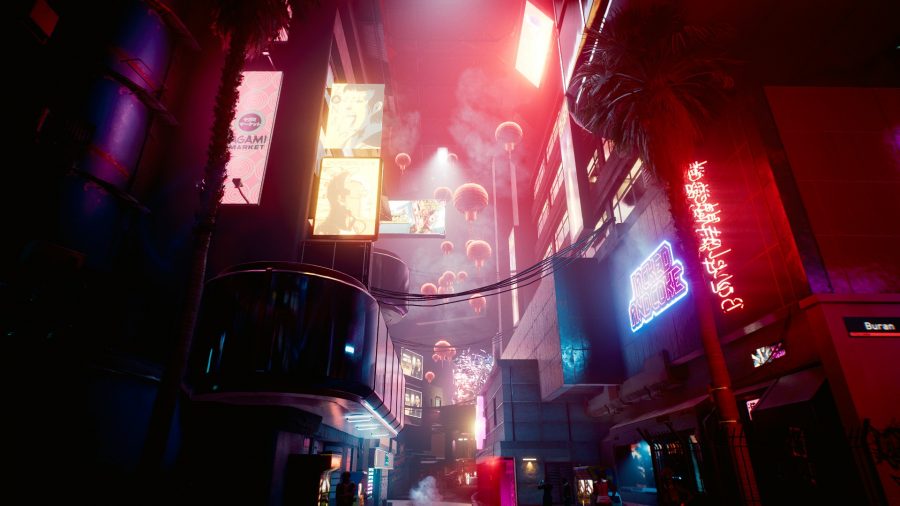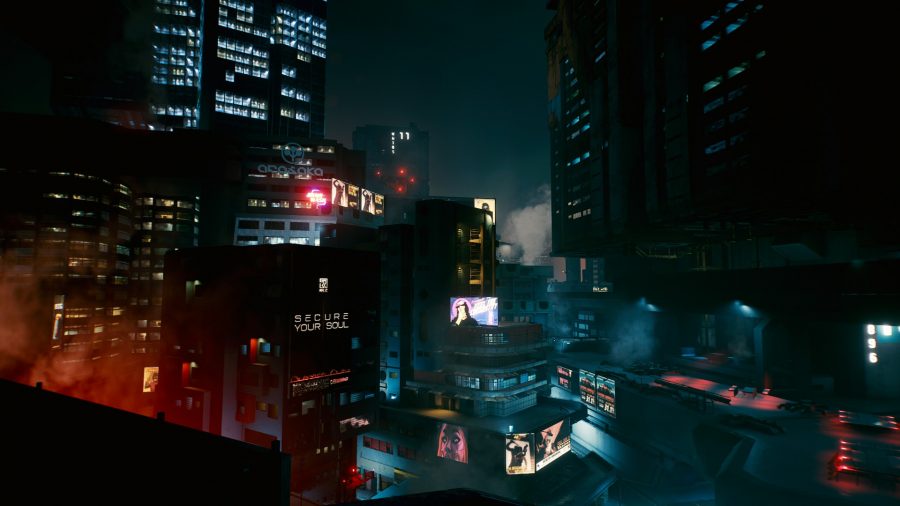There’s a familiar motorcycle available for purchase in Cyberpunk 2077 called the Yaiba Kusanagi CT-3X. You can get it from the fixer Wakako Okada after gaining a street cred level of 12 in the Westbrook district, and it will cost you a hefty 22,000 eddies.
Even from a glance its striking red chassis, the 1988 anime classic Akira can’t help but leap to the mind of anyone familiar with it, yet the Kusanagi is not treated with the same furtiveness that videogames usually afford such references to the real world. It has been plastered over several of the pre-release screenshots and the option to buy it is pushed to your phone, just as with many of Cyberpunk’s original in-universe vehicles. Rather than making a subtle nod to a seminal piece of dystopian anime, CD Projekt Red put it front and centre. This is what most of Cyberpunk 2077’s so-called ‘easter eggs’ are like, and it’s weird.
The use of the term ‘easter egg’ to describe secrets in games was popularised in 1980 by Atari’s Steve Wright, after programmer Warren Robinett hid his own credit in Adventure. Traditionally they’ve been very hard to find, snuck in by developers as either references to things they love or jokes unbeknown to their higher-ups, which means they often share a personal or intimate touch. Many deliberately break the fourth wall and speak directly to players.
From finding John Romero’s head in Doom 2 to the sign on a bridge in GTA San Andreas that reads, “there’s no easter egg here, go away”, they give us special moments of discovery to share with our friends. Some players enjoy hunting them so much that entire communities have assembled to track down a game’s final secrets, even ones that they made up, like the never-ending hunt for San Andreas’s Bigfoot, which the developer has insisted does not exist.
Cyberpunk 2077’s easter eggs have none of these qualities. Even the inclusions that make you double take in giddy excitement just feel off. Whether it’s Hideo Kojima making a cameo smack-bang in the middle of Konpeki Plaza, or a Batmobile-like vehicle hidden in a cave next to a lore shard about a superhero, these references do not deliver the knowing, authentic, spontaneous developer-to-player wink that is the essence of an easter egg. They feel planned, every bit as part of the world as the monolithic neon buildings that swarm the skyline, rather than tertiary features that we only discover if we’re lucky or diligent.
From motorbikes to detailed characters with several lines of dialogue, the work needed to add these references means they’re meant to be seen, which creates this strange sense of stolen valour – calling them easter eggs feels as disingenuous as calling the Iron Man skin in Fortnite a ‘subtle’ nod to Marvel’s Avengers. That’s not to say they aren’t worthwhile additions, but rather that they are not easter eggs in the traditional sense. They’re effortfully crafted encounters that serve a singular purpose: to keep the conversation going.
There’s certainly been no lack of discussion about Cyberpunk 2077, and while some of it was surely not intended – the latest talking point is CD Projekt Red’s response to a second class-action lawsuit – it all serves to keep us talking about the game. Cyberpunk isn’t a service game, and while it’ll get DLC, it’s not as conducive to such expansions as, say, a strategy game, where new factions can slot in with ease. It’s an epic single-player RPG, made at huge expense, and CDPR needs to keep it in our minds. To that end, Cyberpunk is at the forefront of repurposing the easter egg for the social media age.
There are famous influencers on in-game adverts and even as quest givers; Portal’s GLaDOS voices an AI character in a side quest, complete with a ‘the cake is gone’ line; and you can throw a ‘Praise the Sun’ emote in the photo mode. Half-Life 3, Demolition Man, The Witcher 3, we could go on. These references may raise a smile, but they’re as unsubtle as a billboard advertisement, and they come at the cost of authenticity.
Recognising that the street preacher outside V’s apartment block is played by a famous streamer immediately makes you dismiss the character completely. That’s not a person, raving about his real thoughts and feelings about cyberware, that’s CohhCarnage. Cyberpunk 2077 is metaphysical Swiss cheese: structurally compromised by its many glaring portals to the real world.
Related: Here are the best cyberpunk games on PC
While the conversation is meant to be ongoing, we inevitably saw the highest expression of this strategy at launch. Cyberpunk’s 2077’s release was built around a fear of missing out, and within hours of going live social media exploded with clips of in-game references to everything from The Office to Blade Runner. From the outside, Cyberpunk looked like it would be packed with pop culture secrets to discover, but in-game they were barely tucked out of sight. Perhaps this is a glimpse at the future of the easter egg: marketing, memes, and the Fortnite-esque erosion of the integrity of even single-player gaming universes.
You can read Rich’s Cyberpunk 2077 review here, or check out our lists of the best open world games and the best RPG games if you’re looking for something a little different.


